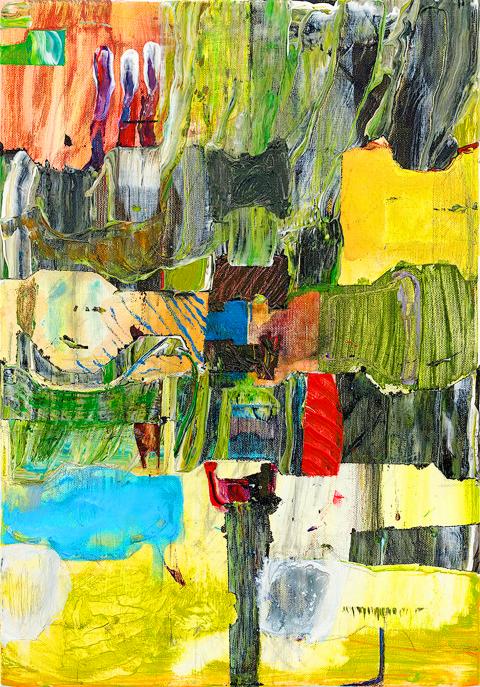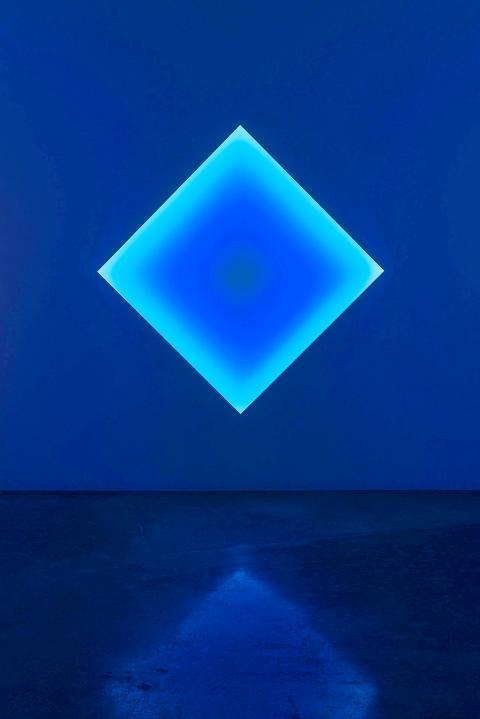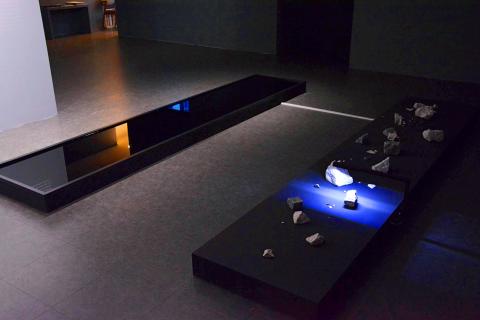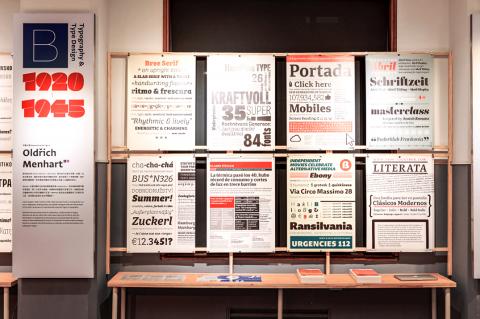Lin Yi-wei (林奕維) is a Taiwanese painter based in Frankfurt and Kaohsiung. His solo exhibition, Hourglass (沙漏), at Gai Art features a series of paintings that correspond to 11 journal entries written in the past year. In these entries, the artist reflects on the immigrant experience, workers and homosexuals. The journals not only serve as inspiration for his paintings, they embody a continuous flow of thought that is intertwined with his daily encounters. Each entry and its corresponding painting are given the same name, and each name announces a strong narrative, such as Reciprocal Shadow: Nudity Camp at Lakeside and Pleasant to Hear the Song Played by DJ Tonight. In contrast, the paintings themselves are suggestive, ambiguous and often contain abstract use of paint. The Road to Return Home for example, depicts stripes of textured color fields stacked on each other, creating a repetitive visual order.
■ Gai Art (㮣藝術), 9-4, Pucheng St, Taipei City (台北市浦城街9之4號), tel: (02) 2363-2000. Open Tuesdays to Sundays from 1:30pm to 7pm
■ Until Dec. 30

Photo courtesy of Gai Art
This year marks 100 years since the birth of Czechoslovakia, a former independent state in Central Europe that formed what we know today as the Czech Republic and Slovakia. On such an occasion, a group design show serves as an opportunity to look back on the shared cultural developments between the now-separated nations. 100 Years of Czech and Slovak Graphic Design (捷克與斯洛伐克平面設計100年) is presently on view at the Taiwan Design Museum. The show mostly consists of cultural publications collected by curator Joe Chang (張軒豪) during his research travels in Europe. Chang is also responsible for the main visual design of the exhibition, which utilizes the Slovakian typeface Klimax, and adopts the colors of both national flags. The exhibited material is organized by chronology and grouped by decade as assemblages of periodic impressions. With a special focus on graphic design, illustration and typology, the show also includes a separate presentation of the International Biennial of Graphic Design Brno, one of the world’s oldest design biennials, which debuted in 1963. There are special talks and events featuring the curator of the Biennial Brno Marta Sylvestrova, and Czech illustrator Tomas Rizek. For more information, visit: www.songyancourt.com/en/tdm/.
■ Taiwan Design Center (台灣設計館), 133, Guangfu S Rd, Taipei City (台北市光復南路133號), tel: (02) 2745-8199. Open Tuesdays to Sundays from 9:30am to 5:30pm
■ Until Feb. 24

Photo courtesy of Alien Art Centre
Chini Gallery (采泥藝術) presents Super Penetrating, a solo exhibition by Chang Yung-ta (張永達). Chang is a multidisciplinary artist whose works span audio-visual art, experimental sound, installation and live performance. His practice centers on observing subtle details in daily life, which he translates into artworks to arouse the senses “in [today’s] highly visual-oriented environment.” The show features installations embedded with micro-sensors that detect radiation signals present in the gallery space. These signals are amplified and made visible through audio and visual techniques. The artist reflects on the significance of this data and the technologies that allow us to perform such monitoring. The artist asks: “In the process of continuously detecting, monitoring, translation and reproduction of data, does that provide us with data of the ideal and safe range? Or is it simply the emergence of the anxiety and warning signs of crises in a technological world that has an uncertain future?”
■ Chini Gallery (采泥藝術), 48, Ln 128, Jingye 1st Rd, Taipei City (台北市敬業一路128巷48號), tel: (02) 7729-5809. Open Tuesdays to Sundays from 10:30am to 7pm
■ Until Jan. 1

Photo courtesy of Chini Gallery
TKG Plus will open two solo shows this weekend. In Niu Jun-qiang Solo Exhibition 2018 (牛俊強個展2018), Niu Jun-qiang (牛俊強) has created videos, experimental films, photographs and installations that explore the possibility of developing shared narratives based on multiple individual histories. In this show, the artist explores the condition of sight in contemporary times. He opens with several questions: Do we truly possess the ability to see? What happens after we entirely lose our ability to see? Quoting Aristotle, the artist points toward a more philosophical interpretation of sight as a departure point for contemplating the self, existence and the universe. Root of Desire (欲貪孰為本), a solo exhibition by Charwei Tsai (蔡佳葳), features a new body of drawings and video installations that draw inspiration from the Buddhist text, Vimalakirti Sutra. “This ancient spiritual text is one of the first recorded in Asia that discusses women’s rights and gender equality,” writes the gallery. In several works, excerpts of the text are incorporated to address correlations between desire, rootlessness, impermanence, nature and emptiness.
■ TKG Plus Projects, B1, 15, Ln 548, Ruiguang Rd, Taipei City (台北市瑞光路548巷15號B1), tel: (02) 2659-0798. Open Tuesdays to Sundays from 11am to 7pm
■ Until Jan. 20

Photo courtesy of Taiwan Design Museum
Alien Art Centre presents James Turrell, featuring prominent American artist and avid pilot of the same name. Turrell is known for his awe-inspiring light installations that push the limits of human perception. “My work has no object, no image and no focus,” writes the artist. “You are looking at what you are looking [at]. What is important to me is to create an experience of wordless thought.” Turrell is a pioneer of the Light and Space movement, a direction of American minimalist art in the 1960s and 70s that concerned itself with geometric shapes and illumination and its effect on the environment. One of Turrell’s most famous pieces is his ongoing project, Roden Crater, in northern Arizona. The artist has worked within the bowel of a crater to “cut a series of chambers, tunnels and apertures within the volcano that heighten our sense of the heavens and earth.” At Alien Art Centre, Turrell presents his recent work, Corinth Canal Diamonds (Squares on point) Glass, 2016, which is part of a glass-based series initiated in 2004. The work takes inspiration from a narrow navigational route in the Greek archipelago. Traveling along the canal, “while one can only glimpse the broad horizon line, the sky is framed by a high natural wall,” writes the art center in a press release.
■ Alien Art Centre (金馬賓館), 111, Gushan 1 Rd, Kaohsiung City (高雄市鼓山一路111號), tel: (07) 972-1685. Open Wednesdays to Sundays from 10am to 6pm
■ Until Dec. 30

Most heroes are remembered for the battles they fought. Taiwan’s Black Bat Squadron is remembered for flying into Chinese airspace 838 times between 1953 and 1967, and for the 148 men whose sacrifice bought the intelligence that kept Taiwan secure. Two-thirds of the squadron died carrying out missions most people wouldn’t learn about for another 40 years. The squadron lost 15 aircraft and 148 crew members over those 14 years, making it the deadliest unit in Taiwan’s military history by casualty rate. They flew at night, often at low altitudes, straight into some of the most heavily defended airspace in Asia.

Taiwan’s democracy is at risk. Be very alarmed. This is not a drill. The current constitutional crisis progressed slowly, then suddenly. Political tensions, partisan hostility and emotions are all running high right when cool heads and calm negotiation are most needed. Oxford defines brinkmanship as: “The art or practice of pursuing a dangerous policy to the limits of safety before stopping, especially in politics.” It says the term comes from a quote from a 1956 Cold War interview with then-American Secretary of State John Foster Dulles, when he said: ‘The ability to get to the verge without getting into the war is

Beijing’s ironic, abusive tantrums aimed at Japan since Japanese Prime Minister Sanae Takaichi publicly stated that a Taiwan contingency would be an existential crisis for Japan, have revealed for all the world to see that the People’s Republic of China (PRC) lusts after Okinawa. We all owe Takaichi a debt of thanks for getting the PRC to make that public. The PRC and its netizens, taking their cue from the Chinese Communist Party (CCP), are presenting Okinawa by mirroring the claims about Taiwan. Official PRC propaganda organs began to wax lyrical about Okinawa’s “unsettled status” beginning last month. A Global

Like much in the world today, theater has experienced major disruptions over the six years since COVID-19. The pandemic, the war in Ukraine and social media have created a new normal of geopolitical and information uncertainty, and the performing arts are not immune to these effects. “Ten years ago people wanted to come to the theater to engage with important issues, but now the Internet allows them to engage with those issues powerfully and immediately,” said Faith Tan, programming director of the Esplanade in Singapore, speaking last week in Japan. “One reaction to unpredictability has been a renewed emphasis on